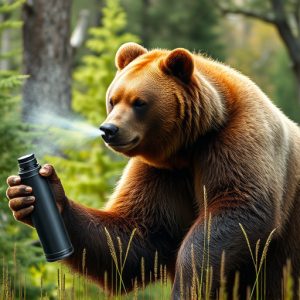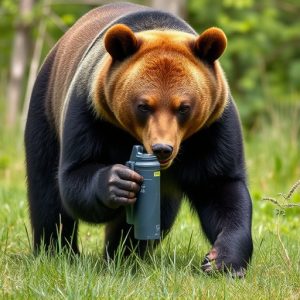Wilderness Safety: Defending Against Grizzly Bears with Bear Pepper Spray Amid TSA Restrictions
Grizzly bears' unpredictable charging behavior poses risks in wilderness areas, making understa…….
Grizzly bears' unpredictable charging behavior poses risks in wilderness areas, making understanding their behaviors crucial for hikers and campers. Bear pepper spray is a vital defense mechanism against charged bears, but TSA restrictions on liquids in carry-on luggage can limit its use during outdoor adventures. Adhering to these restrictions and proper packaging ensure safe travel while maintaining self-defense options in "bear country." Combining bear pepper spray with knowledge of bear behavior enhances safety for those venturing into grizzly bear habitats.
In the vast wilderness, encountering a grizzly bear can be a frightening prospect. Understanding their behavior and charging patterns is crucial for survival. This article explores effective defense mechanisms against these powerful predators, with a focus on bear pepper spray. We delve into its effectiveness, legal considerations, and how TSA restrictions impact your preparedness. Additionally, we uncover alternative safety measures beyond pepper spray, providing essential knowledge for adventurers navigating wild territories.
- Understanding Grizzly Bear Behavior and Their Charging Patterns
- The Role of Pepper Spray in Bear Encounters: Effectiveness and Legal Considerations
- TSA Restrictions on Bear Pepper Spray: What You Need to Know
- Alternative Defense Mechanisms for Wilderness Safety
Understanding Grizzly Bear Behavior and Their Charging Patterns
Grizzly bears, known for their immense strength and unpredictable nature, often charge as a form of defense or to protect their cubs. Understanding their behavior is crucial when navigating wilderness areas they inhabit. These bears have an excellent sense of smell and hearing, which they use to detect potential threats. When encountering humans or other perceived dangers, grizzlies may charge as a means of intimidation or to assert dominance.
Charging patterns vary; some bears may move slowly at first, allowing humans to retreat, while others charge aggressively from the get-go. The use of bear pepper spray is recommended by experts, but it’s important to note that TSA restrictions on liquids might limit its accessibility during outdoor adventures. Knowing these behaviors can help hikers and campers make informed decisions, ensuring a safer experience in grizzly bear country.
The Role of Pepper Spray in Bear Encounters: Effectiveness and Legal Considerations
In many outdoor activities, particularly in regions with a significant presence of grizzly bears, pepper spray is often seen as a crucial defense mechanism. Its effectiveness against charged bears has been a topic of interest and research. Bear pepper spray, when used correctly, can create a temporary but critical window for escape or retreat. The active ingredient, capsaicin, disrupts the bear’s sense of smell and vision, allowing the individual to move away from danger.
However, it is essential to consider legal restrictions, especially when traveling. The Transportation Security Administration (TSA) has specific guidelines regarding bear pepper spray, limiting its transport in carry-on luggage due to potential risks and concerns over misuse or accidental activation during flights. These regulations reflect the delicate balance between personal safety and aviation security. Understanding local laws and their impact on self-defense tools like pepper spray is vital for anyone venturing into grizzly bear country.
TSA Restrictions on Bear Pepper Spray: What You Need to Know
When preparing for encounters with grizzly bears in the wilderness, many adventurers turn to bear pepper spray as a crucial defense mechanism. However, it’s essential to understand the TSA (Transportation Security Administration) restrictions on carrying bear pepper spray while traveling. The TSA has specific guidelines regarding liquids and aerosols allowed in carry-on baggage, which include restrictions on bear spray due to its potential as a weapon.
Bear pepper spray is classified as a hazardous material, and these restrictions apply even if the canister is empty or has been partially used. To comply with TSA regulations, ensure you pack your bear spray in checked baggage and follow the packaging guidelines for size and labeling. Remember, staying informed about these restrictions is vital to ensuring a safe journey into bear country without compromising your ability to defend yourself against unexpected encounters.
Alternative Defense Mechanisms for Wilderness Safety
In addition to physical barriers and noise deterrents, there are several alternative defense mechanisms that can enhance wilderness safety against charging grizzly bears. One such effective tool is bear pepper spray, designed specifically for outdoor use and approved by the TSA for airline travel. Unlike traditional pepper spray used for self-defense in urban settings, bear pepper spray formulations are tailored to disrupt a bear’s sensory perception without causing long-term harm.
When considering the purchase of bear pepper spray, it’s crucial to understand TSA restrictions on liquids and aerosols. Ensure the product meets the requirements for carry-on luggage or is properly packed for checked baggage. Proper usage training is also essential, as incorrect application may not provide adequate protection. Additionally, combining bear pepper spray with knowledge of bear behavior and avoidance techniques offers a multi-layered defense strategy for a safer wilderness experience.
When venturing into bear country, ensuring your safety is paramount. While bear pepper spray remains a popular defense mechanism, understanding its limitations in terms of TSA restrictions is crucial. Knowing how and when to deploy it effectively can make all the difference. Additionally, exploring alternative defense mechanisms offers valuable wilderness safety options for those seeking well-rounded preparation against unexpected charging grizzly bears.


